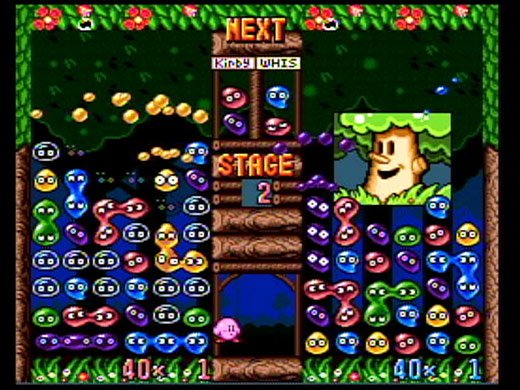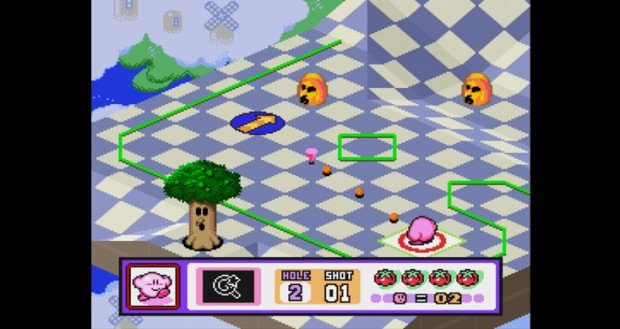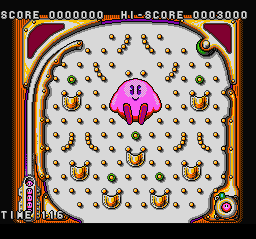Kirby and the Rainbow Curse is just around the corner, and with the release of what looks to be one of the best Kirby titles in a long time, it seems appropriate to take a look at some of the more unusual Kirby titles. We all remember the Kirby’s Dream Land trilogy, Kirby Super Star, and the Nintendo 64’s Crystal Shards, but you might be surprised at some of the gaming adventures that the pink puffball has gotten himself into. It’s worth noting that the bulk of these titles are available on various Virtual Console platforms, if you find yourself so inclined to check them out.
Kirby’s Pinball Land (Game Boy)
HAL Laboratory was no stranger to pinball games, with this being their third title after Rollerball and Revenge of the ‘Gator, but this is obviously the one that most people remember due to who starred in it. Believe it or not, this was the first ever spin-off and ancillary title in the Kirby series, which would go on to become long and varied.
The Game Boy game posits Kirby as the resident pinball (in an idea that actually makes a lot of sense, rather than this being a forced premise), as you work your way through three tables, each based on a boss from the Kirby world, Wispy Woods, Kracko, and one of the Poppy Bros. (the Senior one, if that’s important to you). This culminates in a battle against King DeDeDe in what’s a pretty satisfying, full pinball game. There were also some pretty innovative ways to recover lives and lost balls, too.
And speaking of innovation, the game also came with a built-in rumble pak feature in some very impressive creativity that caused the title to also stick out, as well as becoming the framework for what the later Pokemon Pinball was formed upon.
Kirby’s Avalanche (Super Nintendo)
First off, this game is called Kirby’s Ghost Trap in Europe, so if you’re from over there and familiar with the game under that title, you’re on the winning side of things because how cool is that for a name? The interesting story behind this release is that over in Japan it’s not a Kirby game at all, but rather, Super Puyo Puyo. For its Western release the game oversaw the Kirby makeover to make it more palatable. Although the idea of changing the Puyos to ghosts is a little puzzling. Changes included things like full Kirby custscenes in between stages, and only one Puyo Puyo song remaining, with the rest of the music being remixed Kirby’s Adventure and Dream Course songs

Kirby Tilt ‘n’ Tumble (Game Boy Color)
Just like how Kirby’s Pinball Land was innovative by having a rumble pak incorporated into it, Kirby Tilt N’ Tumble featured motion controls that were way ahead of their time. The built-in accelerometer also gave the cartridge a bigger, transparent pink appearance, which is also kind of darling. The game sets out to have you controlling Kirby as he falls around, as you guide him between goals, collecting stars, in the allotted amount of time. This is all done by turning and positioning your Game Boy Color around. You can even make Kirby jump into the air (called “popping”) by abruptly jerking your Game Boy upright.
This is a pretty great gameplay experience, that was even more unique at its time. The controls are responsive and work well and it’s a neat twist on this sort of “puzzle” genre. It was definitely pushing boundaries. The frantic turning and jerking of your Game Boy actually created a good deal of tension and really suspenseful gaming that the Kirby series lacked otherwise. Funnily enough, this game is compatible with the Game Boy Player for GameCube compatibility, but due to how the cartridge is positioned with the GameCube, you’d have to literally tilt and sway your GameCube system to make it actually playable. In fact, a sequel to Tilt ‘n’ Tumble was even being planned for the GameCube (and Game Boy Advance), before ultimately being scrapped.
Kirby’s Dream Course (Super Nintendo)
In another spin-off move that feels like it makes sense in the same vein as Kirby’s Pinball Land, here Kirby is your golf ball that you politely thwack through eight holes on different courses. Surprisingly though, this was developed as another title entirely to begin with, called Special Tee Shot (which did eventually still see release in Japan). Like a lot of golf games from this time, it used an isometric view of the board, as you control the power, angle, and spin of your ball/Kirby as you try and have him connect with the enemies spread throughout the course. Once you’re down to the final foe, he’ll transform into the hole that becomes your destination. To complicate the basic golf mechanics even further, Kirby’s typical transformations (to be specific the tornado, spark, UFO, parasol, and stone ones) are a large part of the game, sometimes even being required for completing a hole. While pretty complicated, it’s still a lot of fun, a different take on golf, and has an impressive amount of content, like earning bronze, silver, or gold medals at the end of courses which unlock content, as well as different two-player courses as well.

Kirby Fighters Deluxe (3DS eShop)
What started as a sub-game in Kirby: Triple Deluxe, Kirby Fighters was a deeply fun, pretty simple Smash Bros.-esque arena fighter. The sub-game gained such acclaim and fandom that it was expanded into its own game, Kirby Fighters Deluxe, as a 3DS eShop title. Kirby Fighters Deluxe (and its simpler predecessor) sees you using many of Kirby’s copy abilities and battling the deep roster of characters in his universe, as well as the fancy new Shadow Kirby. It’s also nice that each stage is based on a level from a former Kirby game too (with the Kirby 64 stage being particularly nice) in a welcome touch of nostalgia.
While there’s not much to it, it’s a lot of fun and feels a lot like a sort of Kirby-centric Smash Bros. spin-off that grew into something bigger. There are also some great multiplayer modes and options at your disposal as well. The Smash Bros. association makes sense, considering the mind behind the game (and Kirby himself) was Masahiro Sakurai who was also responsible for the other popular fighting series.
Kirby Air Ride (GameCube)
Originally developed as a late-in-the-game Nintendo 64 title, it shouldn’t have been such a bold move for Nintendo to transport Kirby into the world of racers, considering Mario Kart had been such a success for them. However, for whatever reason Kirby Air Ride never gained huge acclaim and was very much a cult title. Kirby Air Ride was different from other racers due to the fact that you didn’t have to push anything at all to move your vehicle forward. These simplistic controls (which were in fact a little too simplistic for most gamers in the end) just involved you using the control stick to steer yourself, and the A Button to do things like boost or brake.
A weird fact about Kirby Air Ride, is that since it was also directed by Sakurai of Smash Bros. fame, Air Ride uses the same grid-like challenge system (with 120 in total) that Smash Bros. became so famous for a few years later. This allows you to unlock a wealth of great content, whether it be new characters, courses, vehicles, or music. This also happened to be the first GameCube title to support LAN play through broadband adapters, in a move that still couldn’t catapult this game to mainstream success.

Kirby’s Block Ball (Game Boy)
A rather derivative Breakout-esque sort of puzzle game, also developed by HAL Laboratory, once again Kirby in ball form becomes your object of choice as you bump him along through levels, trying to break those blocks! While not the most complex Kirby offshoots, the game still offers up boss battles with familiar faces and enough levels to keep you entertained for awhile. If you’re a fan of brick breakers, then you’ll likely enjoy this one, but it’s one of the looser injections of the Kirby world into another genre.
Kirby’s Star Stacker (Game Boy, SNES)
On first impression this game might blend in with the likes of Kirby’s Block Ball or Kirby’s Avalanche, as it’s yet another puzzle title by HAL, but Star Stacker is actually the first Kirby puzzle game that isn’t just a copy of another franchise and is an entirely new property. While this is a wholly original game, that doesn’t stop it from feeling very similar to other puzzling fare from the time, like Tetris or Dr. Mario. Here you match pairs of blocks (all based on Kirby’s animal partners from Dream Land 2) that will eliminate them and earn you stars. While it isn’t a great deal better than the other puzzle games that it resembles, it’s still a fun, quaint time and it’s always nice to see some Dream Land 2 representation happening. The title was so popular, it was re-released on the Super Famicom in Japan, with the title Kirby’s Sparkling Kids (which is kind of beautiful), but often known as Kirby’s Super Star Stacker, too. The re-vamped titled included an added Story Mode featuring characters from Kirby Super Star.
Kirby’s Toy Box (Super Famicom Satellaview)
Truly the weirdest and most obscure Kirby title on the list, Kirby’s Toy Box was only released via the Super Famicom’s Satellaview internet hook-up service. As a result only a small sect of Kirby fans had access to this. The game largely worked as a means to promote Kirby Super Star, with Toy Box containing 8 minigames that all complimented Kirby Super Star’s gameplay and format. It was kind of a novel idea that depending on when you logged on, different games would be available at different times, almost like a surprise. The minigames were: Baseball, Pinball, Star Break (a Breakout clone), Balls Round and Round (think skeeball), Cannonball (a missile command-type game), Pachinko, Arranging Balls (a Connect Four-ish/Pachinko hybrid), Ball Rally (an obstacle course). The Megaton Punch and Samurai Kirby minigames from Kirby Super Star are also included here, identical to their Super Star versions.

While it’s fair to say that not all of these games are classics, it’s nice to see the Kirby franchise experiment so much and vary up their style. It’s rare to see a developer be so fluid with such a popular character, and as a result, the Kirby has been one of the most satisfying game collections ever put together. Even with Rainbow Curse returning to platforming, the gameplay and art design are so different, it’s great to see that Kirby is still as ambitious as ever.